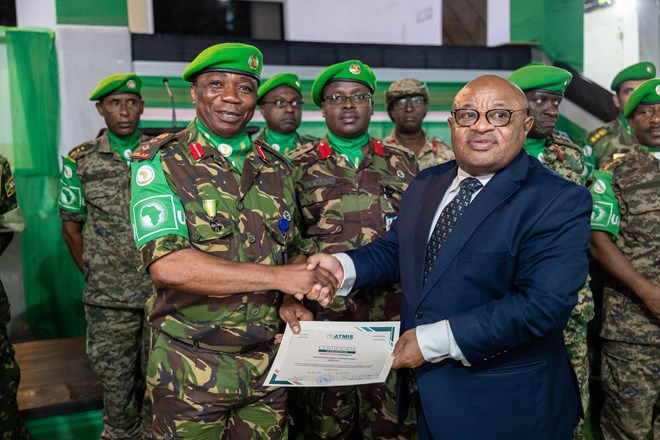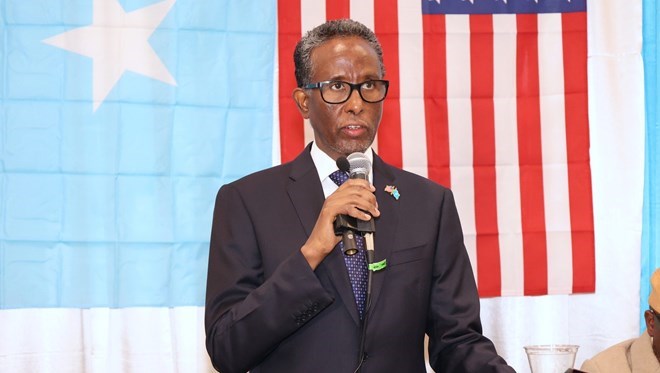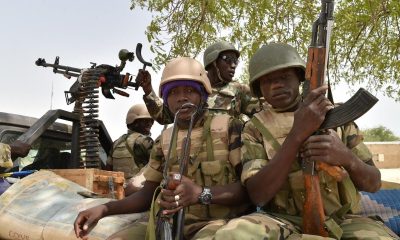Analysis
Ramaphosa names bloated new South African Cabinet

South African President Cyril Ramaphosa has unveiled a new Cabinet for his government of national unity. This comes after weeks of intense political deal-making, as Ramaphosa strives to bridge the gap between a fractured electorate and a parliament now teeming with a colorful mix of characters — from a former armed robber to a white Afrikaner nationalist.
The need for this unprecedented coalition arose after the African National Congress (ANC), which has ruled South Africa since the end of apartheid, suffered a stunning blow in the May elections, losing its majority. Ramaphosa’s solution was to form an inclusive government, bringing together 10 opposition parties, each with its own agenda and history of animosity towards the others.
To appease these factions, Ramaphosa has created a somewhat unwieldy Cabinet, now bloated to 32 ministers and 43 deputy ministers. “The establishment of the government of national unity in its current form is unprecedented in the history of our democracy,” Ramaphosa declared, emphasizing the necessity of this approach to advance national interests and reflect the election results.
Despite the noble rhetoric, this government must confront serious internal contradictions. The ANC secured 20 of the 32 Cabinet posts, while the Democratic Alliance (DA), long a thorn in the ANC’s side, took six. The remaining posts went to smaller parties, resulting in a diverse yet potentially discordant mix.
John Steenhuisen, DA leader and the new agriculture minister, acknowledged the challenges ahead. “The road ahead will be difficult,” he conceded, yet he pledged to work towards making this coalition successful. “It is now up to all of us — including the voters who created this multi-party government — to ensure that it delivers on its promise.”
This coalition is born from necessity. The ANC’s plummeting popularity, down to 40% of the vote, reflects widespread dissatisfaction with economic mismanagement, soaring unemployment, and rampant corruption. Conversely, the DA, which garnered 22% of the vote, is tasked with revitalizing key economic sectors, including agriculture and public works and infrastructure.
However, not everyone is on board with this unity government. The uMkhonto weSizwe party, led by the corruption-tainted former President Jacob Zuma, and the radical Marxist Economic Freedom Fighters (EFF), both refused to join, citing objections to the DA’s involvement. These parties, now relegated to the opposition benches, will undoubtedly continue to challenge the coalition’s initiatives.
Other smaller parties, however, have joined the government, bringing their own controversies. The anti-immigrant Patriotic Alliance, led by ex-gangster Gayton McKenzie, has seen its leader appointed as minister for sports, arts, and culture. Meanwhile, the right-wing, white nationalist Freedom Front Plus has its leader, Pieter Groenewald, taking the helm at correctional services.
The irony of the DA, a party that has long criticized the ANC for bloated governance and cronyism, now participating in a government with 75 ministers and deputies, is not lost on observers. David Everatt, a politics professor at the University of the Witwatersrand, highlighted this paradox, noting that the DA now finds itself in the very position it once lambasted.
This government of national unity faces a monumental task. It must not only navigate its own internal contradictions but also address the critical issues that led to the ANC’s electoral decline. High unemployment, economic instability, and systemic corruption are just the tip of the iceberg.
Moreover, Ramaphosa must balance the demands of his coalition partners while delivering tangible results to a skeptical and impatient public. The success or failure of this bold political experiment will shape South Africa’s future and possibly redefine its political landscape.
As South Africa watches this diverse coalition attempt to govern, one can’t help but wonder: Can such a disparate group set aside their differences for the common good? Or will the internal strife prove too great, leading to another chapter of political turmoil in a country already weary from decades of struggle?
This bloated Cabinet may be South Africa’s best hope for stability and progress, or it could be a recipe for disaster. Either way, it’s a political gamble with high stakes for all involved.
Analysis
From Cell to Summit: The Prisoner Who Became Syria’s President

Ahmad al-Sharaa’s leaked prison past upends Syria’s new narrative—just as he prepares to sit at the Arab League table.

Leaked documents reveal Syria’s new president Ahmad al-Sharaa was once imprisoned in Iraq under a fake name. The story reshapes Syria’s post-Assad era.
The Syrian revolution’s most surprising twist just detonated across the Arab world: Ahmad al-Sharaa, the man now leading Syria’s transition after the collapse of Assad’s regime, was once a prisoner in Iraq—detained by the U.S. for six years under a false identity.
This revelation isn’t just a backstory—it’s a political earthquake. Documents independently verified show that al-Sharaa, under the alias Amjad Muzafar Hussein Al-Nuaimi, was arrested in 2005 and held at Taji prison until 2011. It wasn’t a mistake. It was strategy: fluent in a Mosul dialect and armed with forged papers, he evaded detection during the height of America’s war in Iraq.
That prison sentence forged more than just survival—it built a legend. Al-Sharaa returned to Syria in 2011 as the uprising began, aligned briefly with jihadist factions, including Al-Qaeda and ISIS, before launching his own faction: Hayat Tahrir al-Sham (HTS). By 2016, he had reinvented himself again—breaking with extremism and consolidating control over Idlib, Syria’s last opposition stronghold. In short, he didn’t just witness the Syrian conflict—he dominated it.
Now, just months after Damascus fell and Assad’s regime collapsed, this same man—once known only as Abu Muhammad al-Golani—is Syria’s interim president. He’s set to appear on May 17 at the Arab League summit in Baghdad, and the world will have to decide: is al-Sharaa a revolutionary hero, or a militant with a new mask?
Why does this leak matter now? Some suspect Iranian sabotage, others blame rivals inside Iraq. Either way, it exposes a narrative Syria’s new government hoped to bury. Al-Sharaa isn’t a clean-suited technocrat or a Western-trained reformer. He’s a battlefield survivor, molded by war, prison, and ideology.
For some, that’s exactly what Syria needs—a fighter who outlived Assad, the jihadists, and foreign occupations. For others, it’s proof that Syria’s future remains in the grip of men shaped by conflict, not consensus.
But one thing is clear: the war may have changed Syria’s map—but it never let go of its characters. From the shadows of a jail cell to the heights of Arab diplomacy, Ahmad al-Sharaa’s arc captures the volatile DNA of the new Syria.
Reshuffling the Middle East: Israel’s dilemma in the Syrian chaos
After Assad: Will Syria’s new leaders avoid the cycle of brutality?
Who is Asma Assad, the London-born wife of Syria’s deposed dictator?
Syria After Assad: Former prisoners speak of freedom and lingering pain
Iran and Turkey’s condemnation of Israel’s role in Syria: The battle for influence
Syria’s New Leadership: A Rising Force or Another Regional Rival?
Turkey’s Imminent Invasion into Syria Could Spark Regional Chaos
US Removes $10M Bounty on Leader of Rebel Group Now in Charge of Syria
Assad’s Relatives Detained at Beirut Airport Amid Syrian Regime Collapse
Russia’s Currency Airlift to Syria: A Power Play Against Western Sanctions
Russian Delegation Seeks to Secure Military Bases in Syria After Assad’s Fall
Syria Foils Islamic State Bomb Plot at Shiite Shrine Amid Sectarian Tensions
Assad’s Former Aide Claims Putin “Tricked” Deposed Syrian President During Final Days
Post-War Syria: Challenges Loom as Rebel Coalition Faces Uncertain Transition
The Retreat of Iranian Proxies in Syria and Its Broader Implications
Analysis
America Pulls the Plug on Somalia: UN Funding Blocked, AUSSOM on the Brink

Trump eyes embassy closures as US rejects UN plan to fund peacekeepers in Somalia — Mogadishu’s last lifeline in peril.

The US shocks the UN by rejecting funding for African Union forces in Somalia, just as Trump weighs closing the US Embassy in Mogadishu. With Al-Shabaab advancing and oil politics heating up, is Somalia doomed to implode?
The United States just signaled the collapse of Somalia’s last fragile security architecture — and it did so with chilling clarity. Washington has publicly rejected UN efforts to fund the African Union Stabilization Support Mission in Somalia (AUSSOM), effectively gutting any hope for predictable peacekeeping operations in a country teetering on the edge of collapse.

This isn’t just a bureaucratic snub — it’s a geopolitical death sentence for Somalia. Al-Shabaab militants are already testing the vacuum, launching a multi-pronged assault on Adan Yabaal, a key military base in Middle Shabelle. If confirmed, the town’s fall would mark the largest strategic loss since Somalia launched its offensive against terror in 2022.
UN Secretary-General António Guterres warned the Security Council: no funding, no peace. But the US—under Trump’s second-term posture—is slamming the door shut, labeling Somalia as unfit for a hybrid funding model under Resolution 2719. Diplomats are in a panic. Meanwhile, Trump is reportedly planning to close up to 30 diplomatic missions, with Mogadishu’s embassy topping the list.
Somalia’s response? Desperation disguised as diplomacy. The FGS is now peddling oil blocks in contested territories like Nugaal Valley. In a flashy announcement on X, Somalia’s ambassador to the US declared “Somalia is open for drilling,” targeting American firms with an offer it legally and militarily cannot secure.

Somalia’s Ambassador to the United States, Dahir Hassan Arab
The move comes after Somalia’s recognition of SSC-Khaatumo — a region still engulfed in the political wreckage of its war with Somaliland.
This isn’t about development. It’s about weaponizing recognition, resource manipulation, and fake sovereignty in a bid to win Trump’s favor and undermine Somaliland’s momentum.
But while Hargeisa builds forests and attracts foreign media praise, Mogadishu is drowning in debt, insurgency, and denial. The West is tuning out, and even the UN is losing patience. The US, once Somalia’s diplomatic oxygen, is now pulling the plug.
Somalia is not rising — it’s being unplugged.
Analysis
Somalia’s Egypt-Eritrea alliance is no anti-terror pact — it’s a Nile-fueled power play against Ethiopia

Proxy Firestorm in the Horn.

New Georgetown report warns: the Horn of Africa is on the brink of a regional war.
Somalia’s Gamble in the Horn.
As Ethiopia flirts with Somaliland recognition, Somalia deepens ties with Egypt and Eritrea—fueling a proxy showdown in the Horn of Africa. A new Georgetown report warns of a geopolitical powder keg.
TACTICS OR TROJAN HORSES? SOMALIA’S NEW ALLIANCES COULD IGNITE THE HORN
Somalia isn’t just shifting alliances — it’s detonating new frontlines. A new report from the Georgetown Journal of International Affairs tears the veil off Mogadishu’s widening web of military deals and exposes a regional arms race that’s dragging Egypt, Ethiopia, Turkey, and Eritrea into what could become Africa’s next great conflict.
The flashpoint? Somaliland. The January 2024 port access deal between Somaliland and Ethiopia, in which Ethiopia would gain maritime rights in exchange for recognition, has shattered old assumptions. Furious, Somalia raced into the arms of Egypt and Eritrea — two states that already view Ethiopia as a regional nemesis. Egypt’s military cargo to Somalia in early 2025 wasn’t about fighting Al-Shabab — it was about squeezing Ethiopia over the Nile.
The report warns: peacekeeping missions like AUSSOM are no longer neutral. They’re being manipulated by rival states to project hard power under soft banners. With Ethiopia’s troops still embedded in Somalia’s stabilization efforts, the stage is set for internal sabotage masquerading as peace.
Mogadishu’s sudden outreach to Azerbaijan and Turkey further muddies the waters. The UAE, Russia, and China are already entrenched through ports and military outposts, turning Somalia into the ultimate battlefield for global influence.
Forget diplomacy — this is geopolitical brinkmanship at its rawest. The Horn of Africa is becoming a chessboard of oil, access, and arms, and Somalia just moved its queen into check.
WARYATV.COM | FRONTLINE ANALYSIS
Analysis
How Iran, China, and Russia Are Building a Shadow Empire to Cripple the West

The 2025 U.S. threat report reveals a chilling escalation—America’s enemies are no longer acting alone. Welcome to a world where Iran trains proxy killers, China hacks satellites, and Russia prepares nukes in orbit.
WARYATV Exclusive Analysis
What happens when four of America’s most dangerous enemies start coordinating? According to the U.S. Intelligence Community’s 2025 Threat Assessment, we’re already in that nightmare—and the world’s balance of power is tilting fast. Iran, Russia, China, and North Korea are no longer just isolated threats; they’re actively aligning to undermine the West on every front—military, cyber, economic, and even orbital warfare.
Iran is arming to the teeth and rallying its regional proxies—the Houthis, Hezbollah, and al-Shabaab—with precision-guided drones and ballistic missiles aimed squarely at Israel and U.S. forces. Despite its internal crises, Tehran is playing the long game. It’s forging deeper alliances with Russia and China, supplying drones to Moscow and quietly embedding networks inside the U.S. itself, targeting former and current officials.
Meanwhile, Russia has fully shifted to wartime footing. Despite 750,000 casualties in Ukraine, Putin is more defiant than ever. Moscow is stockpiling weapons, deploying nuclear subs near American shores, and now developing a space-based nuclear satellite—a potential Pearl Harbor in orbit. The Kremlin is also flooding the globe with anti-American propaganda using AI-generated influencers and fake news bots.
Then there’s China—the ringleader of digital authoritarianism. It’s no longer just about Taiwan. Beijing is stockpiling critical minerals, buying ports from Greenland to the Horn of Africa, and arming its AI-driven army with satellite killers. China’s Volt Typhoon and Salt Typhoon cyber ops have already penetrated U.S. infrastructure. Next up? LLM-powered disinformation to flood American minds with doubt and division before the 2026 elections.
North Korea? It’s no longer the clownish rogue state. It’s sending troops to help Russia in Ukraine and funneling war profits into its expanding nuclear arsenal. The DPRK now flies hypersonic missiles capable of evading U.S. defenses. Kim Jong Un is no longer begging for attention—he’s trading nukes for influence.
The scary part? These four regimes are increasingly acting as one strategic axis. The U.S. report makes it clear: if war breaks out with one, the others may follow.
Welcome to the new world disorder.

Analysis
South Korea: Ties Established with Syria Amid Shift in Middle East Alliances

Seoul forms ties with Damascus—once North Korea’s close ally—signaling deeper fractures in Kim Jong Un’s global circle.
From Cold War enemy lines to unexpected diplomacy, South Korea has pulled off a quiet but powerful geopolitical win: establishing full diplomatic ties with Syria, a state long entrenched in North Korea’s orbit.
This isn’t just a photo-op. It’s the final piece of Seoul’s 191-state UN diplomatic puzzle—and a direct message to Pyongyang. The deal, signed in Damascus by South Korean Foreign Minister Cho Tae-yul and his Syrian counterpart Asaad al-Shibani, opens the gates for economic collaboration, reconstruction assistance, and developmental aid to a battered but rebuilding Syria.
But the deeper story? Syria’s new transitional government is recalibrating. Under President Ahmed al-Sharaa, Damascus is charting a path away from militant reliance and Iranian dependence. Former HTS affiliates and technocrats now sit together in a reform-minded cabinet that’s prioritizing civil unity, dismantling militias, and inviting investment—from Seoul, not Tehran.
Meanwhile, North Korea is silent. Since Assad’s fall, Kim Jong Un’s state media has hardly mentioned Syria—except for one vague nod to “the Middle East crisis.” And while North Korea once flooded Syria with arms and advisers, it now watches as South Korea lands in the heart of its former ally’s reconstruction blueprint.
Strategically, this could be a diplomatic domino: Syria joined Turkey’s Anatolia Forum, hinting at a new regional outreach effort, even as the country remains divided—with Turkish forces, US-backed SDF, and former militias still active.
Seoul’s next move? Offering its post-war economic miracle model as a blueprint for Syria’s rebirth—and inserting itself into Middle Eastern politics like never before.
Pyongyang has lost a foothold. Washington is watching. Beijing is calculating. And Syria? It may have just opened its gates to a brand new alliance map.
Analysis
Trump’s Iran Deal: Will Israel Pay the Price for Loyalty?

As nuclear talks resume, Israeli defense officials fear Trump’s quest for a symbolic win could come at the cost of national security.

Trump’s unpredictable stance on Iran’s nuclear program is raising alarm in Israel, where top defense figures fear a deal may tie their hands and risk national security.
Israel’s generals are biting their tongues — but not their worries. Behind closed doors in Tel Aviv and within the Mossad’s fortified halls, a rising fear is taking hold: that Donald Trump, the self-declared “best president Israel’s ever had,” might cut a flashy but hollow deal with Iran that leaves the Jewish state more exposed than ever before.
There’s no question Trump has been a close friend to Israel — moving the embassy to Jerusalem, recognizing the Golan Heights, and greenlighting regional realignments. But even friendships have limits, and this one is now being tested on the most existential front of all: Iran’s nuclear program.
Trump’s history of dramatic diplomacy — from North Korea’s empty stage shows to flirtations with Putin — has Israeli strategists fearing the return of the JCPOA nightmare under a different name. Despite Defense Secretary Pete Hegseth’s saber-rattling and a beefed-up US military presence near Iran, the concern is that Trump will trade meaningful nuclear rollbacks for symbolic gains to score a quick political win. Close a facility? Iran can build another. Destroy some old centrifuges? Tehran has next-gen tech ready to roll.
And while Trump may boast of cutting a deal “better than Obama’s,” Israeli intelligence knows the truth can be buried beneath tons of uranium — or moved silently underground.
Netanyahu’s dance with Trump hasn’t reassured anyone either. The Israeli PM left his own security cabinet in the dark after meeting with Trump, raising eyebrows by sidelining dissenting voices. Worse, there’s been no hint from Washington of a hardline “Libya model” disarmament — just whispers of concessions.
The result? A growing chorus within the IDF and Mossad saying, if Trump seals this deal, Israel may lose its last, best window to strike Iran’s program before it’s buried too deep to touch.

Trump may be Israel’s most bombastic friend. But in the realm of nuclear diplomacy, Israel needs precision, not pageantry. A weak deal now could leave Jerusalem isolated, handcuffed, and with no choice but to act alone — or too late.
Analysis
Merz’s Coalition: Germany’s Answer to Trump’s Trade Blitz and Putin’s War Machine

Under pressure from Trump’s tariffs and Putin’s aggression, Germany’s new chancellor builds a rapid-fire coalition to reassert European leadership and restore stability.
Friedrich Merz seals a high-stakes coalition to counter Trump’s economic shockwaves and Putin’s war threats. Germany is back—with debt-fueled defense, tougher borders, and a warning to Washington.
Germany blinked, then moved fast. With Donald Trump hurling 20% tariffs at the EU and Vladimir Putin digging deeper into Ukraine, Friedrich Merz did what German leaders rarely do—he moved with speed. Just 45 days after his snap election win, Merz sealed a powerful coalition deal with the center-left SPD, not out of political convenience, but out of strategic necessity.
This isn’t just domestic politics—it’s about survival. Trump’s trade war is blowing a hole through Germany’s industrial heartland. Putin, undeterred and emboldened, watches Europe flounder. And the United States, once a security guarantor, now looks more like a wildcard. For Berlin, the old transatlantic order is dead—and Merz knows it.
His coalition, fast-tracked under extraordinary pressure, promises billions in military and infrastructure spending, not out of generosity but to plug the vacuum left by America’s retreat. But Merz’s problem is internal too: while EU leaders cheer the deal, back home his own base sees betrayal—fueled by AfD populists calling him weak on borders and sold out to the left.
That’s why Merz pivoted hard on migration: slamming shut asylum routes, promising deportation surges, and pushing “safe country” designations. It’s a political firewall against the far-right, but also a gamble that could fracture Germany’s social fabric.
Still, Merz had no choice. Trump’s tariffs and unpredictable diplomacy have shattered Europe’s illusions. The era of Germany hiding behind NATO is over. If Berlin wants influence, it has to pay—and fight—for it.
Merz’s message to Trump was simple: Germany is back. But the real message, loud and clear, was to Europe: the gloves are off, and Berlin is done waiting for America.
Analysis
China Strikes Back: Trump’s Trade War Just Triggered a New Cold Front

Beijing fires back at Trump’s 50% tariff with crushing 84% duties, bans on top U.S. defense firms, and a bold message to Washington: Enough is enough.
The trade gloves are off. China has just escalated its standoff with the United States into a full-blown economic cold war. Less than 48 hours after President Donald Trump unleashed a crushing 50% tariff on all Chinese imports, Beijing retaliated with ferocity: 84% total tariffs on U.S. goods and sweeping sanctions on 18 American defense contractors.
This isn’t tit-for-tat. It’s a calculated declaration that China is ready to match Trump’s aggression dollar for dollar — and missile for missile. The 18 companies, including military AI developer Shield AI and elite U.S. Air Force partner Sierra Nevada Corporation, are now blacklisted under Beijing’s “unreliable entities” framework. Translation? They’re locked out of China — no investments, no exports, no excuses.
The timing is as political as it is economic. These firms weren’t just targeted for trade; they were hit for arms deals with Taiwan, the democratic island Beijing vows to reclaim. The message from Xi Jinping’s government couldn’t be clearer: Play with fire in Taiwan, and your defense contractors burn.
So what’s the real fallout? While most of these companies don’t rely heavily on Chinese markets, Beijing knows how to exploit soft points in global supply chains. Just ask U.S. drone maker Skydio, which lost its Chinese battery source overnight after past sanctions. This move isn’t about business — it’s about leverage.
And still, amid this economic artillery exchange, China sends a chilling whisper to global investors: “Don’t worry — this won’t affect the honest ones.” But who defines honesty when geopolitical fault lines crack deeper every day?
Trump wanted a trade war. What he got was China’s economic kill switch flipped — not just in tariffs, but in strategic deterrence.
Because this isn’t just trade. It’s a battlefield — and the weapons are sanctions, supply chains, and national pride.
-

 Analysis1 month ago
Analysis1 month agoSaudi Arabia’s Billion-Dollar Bid for Eritrea’s Assab Port
-

 ASSESSMENTS3 weeks ago
ASSESSMENTS3 weeks agoOperation Geel Exposes the Truth: International Community’s Reluctance to Embrace Somaliland as a Strategic Ally
-

 Somaliland3 months ago
Somaliland3 months agoSomaliland and UAE Elevate Ties to Comprehensive Strategic Partnership
-

 Africa1 year ago
Africa1 year agoHow Somaliland Could Lead the Global Camel Milk Industry
-

 Analysis1 year ago
Analysis1 year agoIran escalates conflict, attacking Israel; US forces help Israel to intercept Iranian projectiles
-

 Top stories11 months ago
Top stories11 months agoGunmen Kill 11 in Southeastern Nigeria Attack, Army Reports
-

 Analysis1 year ago
Analysis1 year agoIsrael and Iran on Edge: Tensions Escalate Amidst Rising Threats
-

 TECH11 months ago
TECH11 months agoZimbabwe Approves Licensing of Musk’s Starlink Internet Service


























